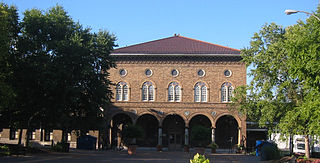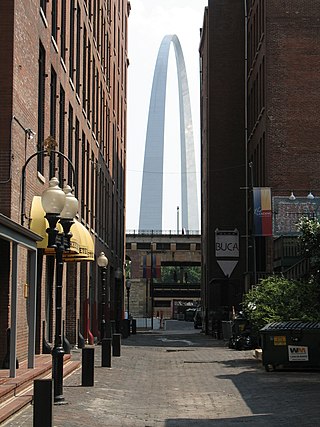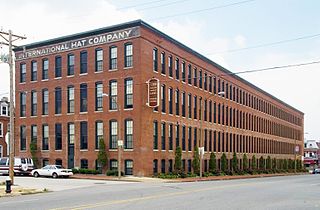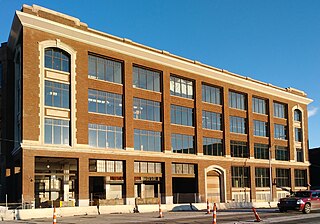
Soulard is a historic neighborhood in St. Louis, Missouri. It is the home of Soulard Farmers Market, the oldest farmers' market west of the Mississippi River. Soulard is one of ten certified local historic districts in the city of St. Louis.

The Washington Avenue Historic District is located in Downtown West, St. Louis, Missouri along Washington Avenue, and bounded by Delmar Boulevard to the north, Locust Street to the south, 8th Street on the east, and 18th Street on the west. The buildings date from the late 19th century to the early 1920s. They exhibit a variety of popular architectural styles of those years, but most are revival styles or in the commercial style that would later come to be known as the Chicago School of architecture. Most are large multi-story buildings of brick and stone construction, built as warehouses for the St. Louis garment district. Many have terra cotta accents on their facades. After World War II, the decline in domestic garment production and the preference for single-story industrial space led to many of the buildings being vacant or underused due to functional obsolescence.

LaSalle Park is an integral part of the three-neighborhood "Old Frenchtown" area—LaSalle Park, Lafayette Square and Soulard—bordering the southern edge of downtown St. Louis. It was formed as a "new" neighborhood, legally distinct from the larger Soulard district, through the efforts of the city of St. Louis, Missouri and Ralston Purina, which has its world headquarters in LaSalle Park.

The Hamilton-Brown Shoe Factory was the first large scale industrial operation in Columbia, Missouri. It was built in 1906-1907 by the Brown Shoe Company, the largest shoe manufacture in the world at the time. It was the first plant built outside of St. Louis and was operational from 1907-1939 The building today has been converted into offices.

The Pittsburgh Plate Glass Company Building, also known as the Northern Implement Company and the American Trio Building, is a warehouse building in downtown Minneapolis, Minnesota. PPG Industries of Pittsburgh constructed the structure.

The Brown Shoe Company Factory is a historic factory located at 212 S. State St. in Litchfield, Illinois. The factory opened in 1917 to produce shoes for the St. Louis–based Brown Shoe Company. Prominent St. Louis architect Albert B. Groves designed the factory, which was one of twelve he designed for the company. The factory became Litchfield's second-largest industry and brought the community prosperity through the Great Depression; in addition, its employees formed a civic organization that created a public park on company property. The factory closed in 1967; it was later used by cabinet manufacturer Adenca.

The architecture of St. Louis exhibits a variety of commercial, residential, and monumental architecture. St. Louis, Missouri is known for the Gateway Arch, the tallest monument constructed in the United States. Architectural influences reflected in the area include French Colonial, German, early American, European influenced, French Second Empire, Victorian, and modern architectural styles.
Caleres Inc. is an American footwear company that owns and operates a variety of footwear brands. Its headquarters is located in Clayton, Missouri, a suburb of St. Louis. Founded in 1878 as Bryan, Brown & Company in St. Louis, it underwent several name changes; for a time, the Hamilton-Brown Shoe Company was the largest manufacturer of shoes in America. It went bankrupt in June 1939.

The Bona Allen Company is a tannery and leather goods factory that opened in 1873 in Buford, Georgia. It became the nation's largest producer of hand-tooled saddles, bridles, horse collars, postal bags, cowboy boots, and shoes and had a contract to supply the sporting equipment giant, Spalding, with raw material for the manufacture of baseballs and baseball mitts. Starting in the early 20th century Bona Allen saddles were offered in the Sears Mail Order catalog under a variety of names. The Bona Allen Company was owned by Bonaparte Allen Sr. Also known as the Bona Allen Shoe and Horse Collar Factory, the factory closed in 1981 after a fire, and the main tannery building was added to the National Register of Historic Places on January 3, 2005. It is located at 554 West Main Street. After another fire on February 10, 2015, firefighters allowed the building to burn itself down.

The Crescent Warehouse Historic District is a 10.5-acre (4.2 ha) historic district in Downtown Davenport, Iowa, United States. The district is a collection of multi-story brick structures that formerly housed warehouses and factories. Most of the buildings have been converted into loft apartments. The district was listed on the National Register of Historic Places in 2003.

Albert Bartleton Groves, also known as A.B. Groves or Albert B. Groves, was an American architect who practiced in the St. Louis, Missouri area.

The Badger State Shoe Company is a classically-styled 6-story shoe factory built in 1910 in Madison, Wisconsin, a half mile north-east of the Capitol. It was added to the National Register of Historic Places on April 11, 1989.

International Hat Company, formerly named the International Harvest Hat Company, was a St. Louis, Missouri-based manufacturer of commercial hats and military helmets. The company was one of the largest hat manufacturers in the United States and, at one time, the largest manufacturer of harvest hats in the world. It is best remembered for its design and mass production of tropical shaped, pressed fiber military sun helmets for service members of the United States Army, Marines, and Navy during and after World War II. Additionally, the American owned company was a major producer of harvest hats, straw hats, fiber sun hats, enameled dress hats, baseball caps, and earmuffs throughout most of the 20th century. However, it is the International Hat military sun helmets that have become the most notable collector's items.

St. John Nepomuk Parish Historic District is centered on the Catholic parish of St. John Nepomuk in the Soulard neighborhood of St. Louis, Missouri, United States. The historic district is listed on the National Register of Historic Places.

Hamilton-Brown Shoe Company Building, now the Selwyn Place Apartments, is a historic factory building located at Boonville, Cooper County, Missouri. It was built in 1919 by the Hamilton-Brown Shoe Company, and is a four-story, rectangular brick industrial building with a flat roof. The roof is framed by a corbelled parapet capped with tile coping. The building features a five-story elevator tower and four-story tower which housed restrooms. Also on the property are the contributing power plant building and oil house.

The Gordon–Van Tine Company Historic District, also known as the U.N. Roberts and Company Buildings, is a nationally recognized historic district located east of downtown Davenport, Iowa, United States. It was listed on the National Register of Historic Places in 2017. At the time of its nomination it consisted of four resources, all contributing buildings. The Gordon–Van Tine Company manufactured pre-cut, mail-order homes in this facility, beginning around 1916.

The Assembly, previously known as the Edson, Moore and Company Building, is a former warehouse building, constructed for Edson, Moore & Company in 1913. It is located at 1700 West Fort Street in Detroit, Michigan, and has been redeveloped into a mixed use space. The building was listed on the National Register of Historic Places in 2017.

The Walker's Point Historic District is a mixed working-class neighborhood of homes, stores, churches and factories in Milwaukee, Wisconsin, with surviving buildings as old as 1849, including remnants of the Philip Best Brewery and the Pfister and Vogel Tannery. In 1978 it was added to the National Register of Historic Places. The NRHP nomination points out that Walker's Point was "the only part of Milwaukee's three original Settlements to reach the last quarter of the Twentieth Century with its Nineteenth and early-Twentieth Century fabric still largely intact," and ventures that "For something similar, one would have to travel to Cleveland or St. Louis if, indeed, so cohesive and broad a grouping of...structures still exists even in those cities."

Ely Walker Lofts is a building located at 1520 Washington Avenue in St. Louis, Missouri.
The M.C. Kiser Company Building is a historic building in Atlanta, Georgia, United States. Located in the South Downtown neighborhood, it was built in 1923 as a shoe factory, converted to apartments in 2017, and added to the National Register of Historic Places in 2019.






















